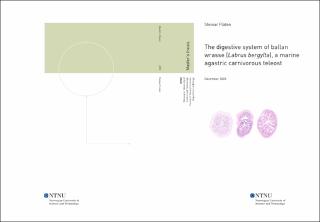| dc.description.abstract | The knowledge of the digestive system of teleosts is limited, especially when considering the huge variation in morphology. There are particularly few studies of the digestive system of agastric (stomachless) teleosts such as the ballan wrasse (Labrus bergylta), one of several species currently used as cleaner fish in Norwegian fish farms. They are known for their ability to graze on parasitic sea lice (Caligidae) which target salmonids specifically.
This study was conducted with the goal of creating a comprehensive descriptive and quantitative overview of the ballan wrasse digestive system. A new method was developed to estimate total intestinal surface area (including microvilli) from serial microscope sections of the digestive tract and accessory tissues. These were removed as one unit and fixated with the goal of preserving the organs' natural position in the buccal cavity. The tissue volume of digestive organs was estimated as well (intestine, liver, pancreas and adipose tissue). Additionally, this study included an analysis of mucus-secreting cells along the digestive tract, specifically a histochemical analysis of mucin content (oesophagus and intestine) and estimates of goblet cell density (intestine).
The digestive tract of ballan wrasse was characterized by the adaptation of the pharyngeal teeth and foregut/oesophagus towards mechanical digestion (pharygnaty) rather than a handling/swallowing function. The rounded molariform pharyngeal teeth are used for crushing the outer shells of exoskeleton-bearing invertebrates (durophagous feeding behaviour).
The mucous oesophagus was lined with a simple cuboidal epithelium, folded into thin blood-filled branches to form a feather-like pattern. This epithelial type (simple, rather than stratified) has not been previously described in the teleost oesophagus. Contrary to what is common for marine teleosts, the ballan wrasse oesophagus did not contain an “oesogaster”, a columnar, microvillous epithelium, believed to function in osmoregulation. It is possible that the feather-like mucosa and thin epithelium serve a similar osmoregulatory function in the absence of the oesogaster.
Although the intestine was short and lacked pyloric caeca, the intestinal surface area of ballan wrasse was, in fact, larger than any of the species that were compared in this study, including gastric and agastric teleosts of various diets/trophic levels and environments. The large intestinal surface area of ballan wrasse can be attributed mainly to the extensive mucosal folding and large microvilli surface area as well as the inclusion of a distended intestinal bulb. | |
